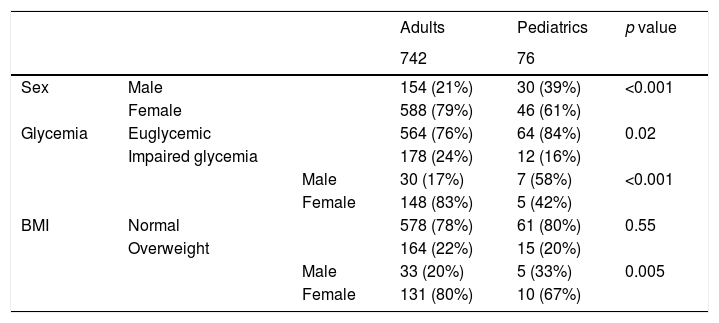To analyze epidemiological and anthropometric features of patients with brown adipose tissue (BAT) activation detected by fluorine18-fluorodeoxyglucose positron emission tomography/computed tomography (18F-FDG PET/CT).
Materials and methodsFrom 2005 to 2017, 818 18F-FDG PET/CT studies positive for BAT detection were retrospectively included, 742 examinations performed on the adult population and 76 PET/CT on the pediatric population. A Chi-squared test was performed to compare features distribution between the adult and pediatric patients.
ResultsAdults showed a higher rate of BAT detection in females (79% vs 61%, p<0.001) and in hyperglycaemic patients (>100mg/dL) (24% vs 16%, p=0.02), no significant difference was found with regard to overweight patients (BMI>25kg/m2) (22% vs 20%, p=0.55). Considering females only, the adults showed a higher rate of BAT detection both in hyperglycaemic (83% vs 42%, p<0.001) and overweight patients (80% vs 67%, p=0.005). In both populations BAT activation happened more frequently in cold seasons; there was no significant distribution difference with regard to season of birth (p=0.2).
ConclusionsSex, glycemia and BMI play a major role in predicting BAT activation, with significant differences between adults and pediatric patients. Cold exposure is confirmed as an important predicting factor, while season of birth is not significant.
Analizar las características epidemiológicas y antropométricas de los pacientes con activación de la grasa parda detectada por tomografía por emisión de positrones con fluoruro 18-fluorodeoxiglucosa/tomografía computarizada (18F-FDG PET/TC).
Material y métodosDe 2005 a 2017, se incluyeron retrospectivamente 818 estudios PET/TC con 18F-FDG positivos para detección de grasa parda 742 exámenes realizados en población adulta y 76 PET/TC en población pediátrica. Se realizó una prueba de Chi cuadrado para comparar la distribución de las características entre pacientes adultos y pediátricos.
ResultadosLos adultos mostraron una tasa más alta de detección de grasa parda en mujeres (79% vs 61%, p<0,001) y en pacientes con hiperglicemia (>100mg/dL) (24% vs 16%, p=0,02), no se encontraron diferencias significativas considerando el sobrepeso (IMC>25kg/m2) (22% vs 20%, p=0,55). Teniendo en cuenta solo a mujeres, los adultos mostraron una tasa más alta de detección de grasa parda tanto en pacientes con hiperglicemia (83% frente a 42%, p<0,001) como en pacientes con sobrepeso (80% frente a 67%, p=0,005). En ambas poblaciones, la activación de la grasa parda ocurrió con mayor frecuencia en las estaciones frías; noón considerando la temporada de nacimiento (p=0,2).
ConclusionesEl sexo, la glucemia y el IMC desempeñan un papel importante en la predicción de la activación de la grasa parda, con diferencias significativas entre adultos y niños. Se confirma que la exposición al frío es un factor de predicción importante, mientras que la temporada de nacimiento no es significativa.
Article
If you experience access problems, you can contact the SEMNIM Technical Secretariat by email at secretaria.tecnica@semnim.es or by phone at +34 619 594 780.

Revista Española de Medicina Nuclear e Imagen Molecular (English Edition)










